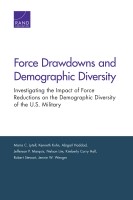| 来源类型 | Research Reports
|
| 规范类型 | 报告
|
| ISBN | 9780833091499
|
| 来源ID | RR-1008-OSD
|
| Force Drawdowns and Demographic Diversity: Investigating the Impact of Force Reductions on the Demographic Diversity of the U.S. Military |
| Maria C. Lytell; Kenneth Kuhn; Abigail Haddad; Jefferson P. Marquis; Nelson Lim; Kimberly Curry Hall; Robert Stewart; Jennie W. Wenger
|
| 发表日期 | 2015
|
| 出版年 | 2015
|
| 页码 | 262
|
| 语种 | 英语
|
| 结论 |
Previous Active-Duty Force Reductions Did Not Generally Decrease Demographic Diversity- Despite major reductions in the size of the active-duty force in all four services in the 1990s, demographic diversity generally increased.
- Although the Navy and Air Force reduced their active-duty forces in the mid-2000s, demographic diversity of those forces generally increased between fiscal years 2001 and 2011.
Specific Drawdown Effects on Demographic Diversity are Unclear- Drawdown decisions do not have clear-cut ties to demographic diversity because the services do not make drawdown decisions with demographic goals in mind.
Certain Drawdown Strategies Could Affect Demographic Diversity- Three categories of workforce characteristics are used to separate active-duty personnel in drawdowns: experience, occupational specialty, and merit. Any of these could affect demographic diversity due to uneven distribution of demographic groups across the three categories.
- Cuts to nontactical operational occupations could adversely affect women and blacks; cuts to tactical operational occupations could adversely affect Hispanic men; cuts based on long service may adversely affect black personnel, but cuts based on short service could adversely affect women; tightening accessions standards could adversely affect both women and minorities.
|
| 摘要 |
- We recommend that services not be required to make drawdown decisions based on gender, race, ethnicity, or other protected status, given legal restrictions on using demographic information in employment decisions.
- However, the services should anticipate potential consequences of drawdown decisions by analyzing potential adverse impacts in advance of implementing particular drawdown policies. The Office of the Secretary of Defense (Personnel and Readiness) should develop policy and direct that such analyses be performed, with assistance from the Office of Diversity Management and Equal Opportunity in executing these analyses.
- The Office of Diversity Management and Equal Opportunity should validate the services' predecision analytic results, which will require the Defense Manpower Data Center to acquire more detailed data for validation.
|
| 主题 | Civilian Military Workforce
; Military Career Field Management
; Military Officers
; Military Personnel Retention
; Military Reserves
; Workforce Diversity
; Workforce Management
|
| URL | https://www.rand.org/pubs/research_reports/RR1008.html
|
| 来源智库 | RAND Corporation (United States)
|
| 资源类型 | 智库出版物
|
| 条目标识符 | http://119.78.100.153/handle/2XGU8XDN/108019
|
推荐引用方式
GB/T 7714 |
Maria C. Lytell,Kenneth Kuhn,Abigail Haddad,et al. Force Drawdowns and Demographic Diversity: Investigating the Impact of Force Reductions on the Demographic Diversity of the U.S. Military. 2015.
|
|
文件名:
|
x1495316252734.jpg
|
|
格式:
|
JPEG
|

|
文件名:
|
RAND_RR1008.pdf
|
|
格式:
|
Adobe PDF
|
除非特别说明,本系统中所有内容都受版权保护,并保留所有权利。